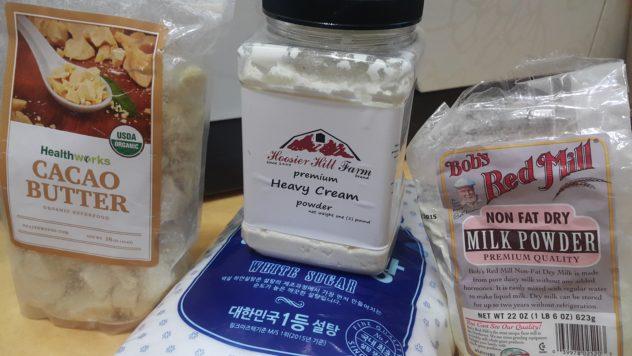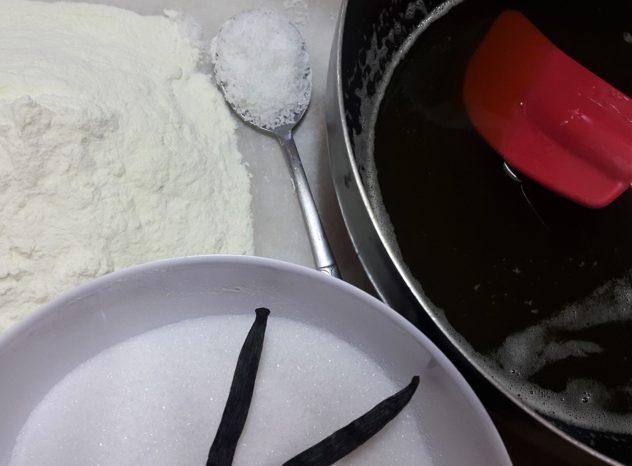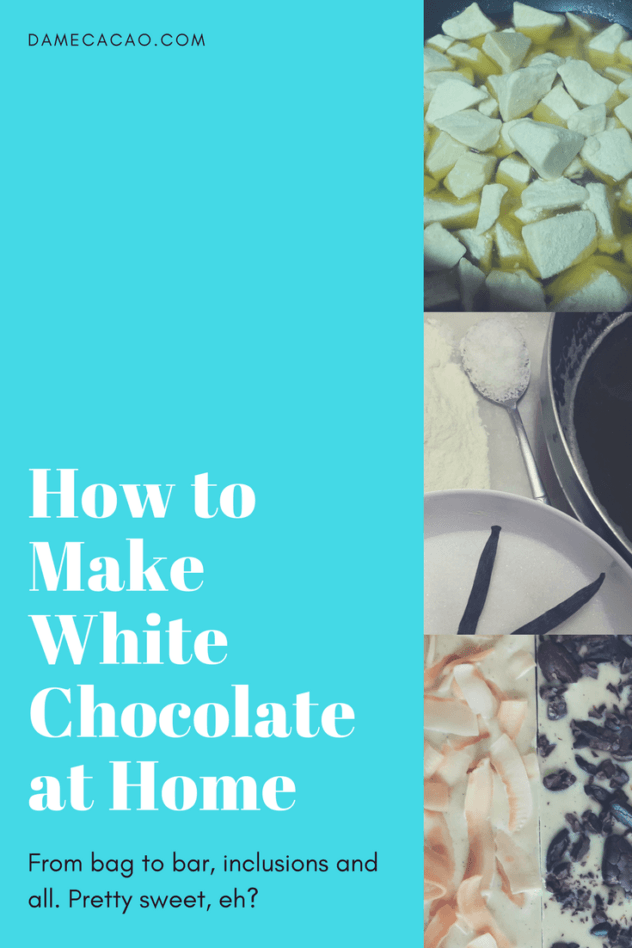As kids, we learn to eat our colors. This chocolate is white, maybe an aged-parchment shade of white, though white all the same. But the packaging, oh the packaging is super colorful. That counts, right? I think my mom would be on board. In fact, she has all the tools to make this "bag to bar" chocolate at home, right now. Pretty sweet, eh?

Making Mistakes in The Process
For this experiment, I utilized my Premiere Wonder Grinder, and a mish-mash of pots & pans and spoons. To start, I weighed my ingredients, and melted the cocoa butter slowly over fire (in one of the aforementioned pots).
Next, I added the butter to my refiner, and slowly added the sugar, and then the milk powders and salt. The sugar changed the color from a yellow-tinged fluid— thick, but liquid— to a thick, pale yellow emulsion with a buttercream frosting consistency. I'd have been happy to put that on a cake, but talk about expensive frosting!
Until the machine is warm enough, your experiment may look panic-inducing thick, but after an hour in the refiner it should fully liquidize. At first the milk powder and salt seemed to thicken the mixture as it lowered the overall fat content, but by refining hour 1 it was splashing away.
If your chocolate is still too viscous after four hours, add a tablespoon of melted cocoa butter at a time, and test how it sets on a plate. The particles will be small enough that this will accurately represent your product. But be careful, because if you add too much the fat ratio will be too high and it will never solidify.
Choosing Inclusions & Influencing Flavors
At this point I let the chocolate refine alone for 2 hours or so with the lid off, as we made dinner. Many makers prefer to add lecithin for better viscosity, but that's just not my preference. The sugar content is still quite high, however, so next time I'll switch the percentages of milk and sugar but maintain the fat ratio.
Feel free to play around, but be careful to keep the fat percentage around 40%, give or take ~4%. I did add vanilla and salt, as well, because I believe it adds depth to white chocolate. After six hours, I tested some of the chocolate to make sure that I hadn't somehow completely miscalculated the fat ratio, but it set nicely.
Making white chocolate at home turns out to be a relatively simple undertaking, if you have the right equipment. So for me, the more adventurous and interesting part of this experiment was adding the flavors the chocolates. With a sweet cream base, most flavors have the ability to really pop.
- Toasted coconut: the fat and caramel crunch contrast well with the sweet and cream of the chocolate.
- Nibs: I've always been a fan of white chocolate with nibs, as the bitterness further intensifies the sweet cream flavor.
- Matcha powder: you really have to add a lot to get the flavor to come across, and it also emphasizes the saltiness, but it tastes like a super sweet green tea latte.
- Coffee: whole bean form lends more coffee flavor to the final product, plus a crunch and bitterness that reminds me of a cappuchino.
- Chai tea: tea must emphasize salt, as this is one of my favorite flavors, though I found it to seem the saltiest of all. Adding the tea to the top made the chai tea latte flavor more pronounced.

The Final Product & Recipe
I refined the chocolate for about 8.5 hours, much less than you would need to refine a dark or milk chocolate. Most all of the flavor will come from cocoa butter's aromatic compounds, so choose carefully. For white chocolate especially, it's most advantageous to use cold-pressed cacao butter, because that's the first press and the most clear of all cacao butters.
Steer clear of deodorized cocoa butter, as it no longer has any odor, and choose organic if you can find it. My final product tasted very sweet and a little too salty, so the next time I used half the salt & it was much better. Coconut and nibs were the favorite inclusions, though the coffee holds a special place in my heart.
Unlike my previous chocolate experiments, this one didn't immediately bloom and it set quite quickly, ready to eat in a matter of hours. Maybe it's the cold weather and low humidity? Either way, this is an experiment that I'll soon repeat— and so can you.
The Recipe
–454g cocoa butter (40% fat/40% by weight)
–363g white sugar (0% fat/32% by weight)
–250g skim milk powder (0% fat/22% by weight)
–68g heavy cream powder (4.2% fat/6% by weight)
–3g salt
–4 vanilla beans (scraped & put into the refiner in the last 5 minutes— any longer and the flavor will begin to dissipate)

If you found this interesting, please pin it!
What kitchen experiments have you had turn out surprisingly well? Any other ideas for toppings?


















Comments
No Comments